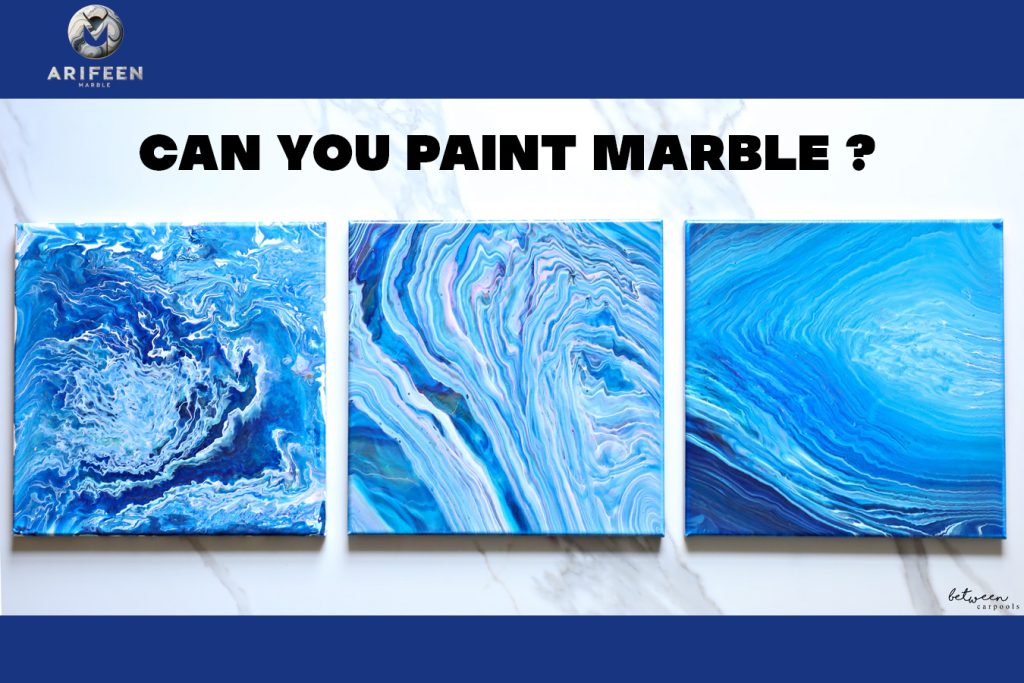Can You Paint Marble

Painting Marble
Marble is known for its timeless beauty and natural elegance, but there may be situations where you want to change its appearance through painting. Whether it’s to refresh an old marble surface or to add a touch of color to your space, painting marble is a viable option. However, there are important considerations and steps to follow to ensure a successful outcome.
Assessing the Surface
Before diving into painting marble, it’s crucial to assess the condition of the surface. Check for any existing damage, such as chips, cracks, or stains, as these may need to be addressed before painting. Ensure the marble is clean and free of any debris or residues.
Choosing the Right Paint
Selecting the appropriate paint is key to achieving a durable and visually appealing finish on marble. Opt for high-quality paints specifically designed for use on stone surfaces. Acrylic paints or specially formulated stone paints are recommended for their adhesion and durability.
Preparing the Marble Surface
Proper preparation is essential for a successful paint job on marble. Follow these steps:
- Clean the surface thoroughly to remove dirt, grease, and other contaminants. Use a mild detergent and water, followed by a rinse and dry with a clean cloth.
- If there are any existing coatings or sealants on the marble, they must be removed to ensure proper adhesion of the paint. Use a suitable paint stripper or solvent as recommended by the paint manufacturer.
- Sand the surface lightly with fine-grit sandpaper to create a slightly rough texture for better paint adhesion. Wipe away any dust with a damp cloth.
Priming the Surface
Applying a primer specifically designed for stone surfaces is crucial to enhance adhesion and ensure a smooth, even finish. Use a high-quality stone primer and follow the manufacturer’s instructions for application and drying times.
Curing and Maintenance
After painting, allow the marble surface to cure fully before subjecting it to heavy use or cleaning. Follow the paint manufacturer’s guidelines for curing times and recommended maintenance practices to preserve the painted finish.
Process
Once the surface is prepped and primed, you can proceed with painting the marble. Follow these steps:
- Stir the paint thoroughly to ensure uniformity.
- Apply the paint evenly using a brush, roller, or sprayer, depending on the size and complexity of the surface. Work in small sections to maintain control and avoid drips or streaks.
- Allow the first coat to dry completely as per the paint manufacturer’s instructions.
- Apply additional coats as needed for desired coverage and color intensity. Ensure each coat is fully dried before applying the next one.
- Optional: Consider applying a clear protective sealer over the painted surface to enhance durability and longevity.
How to Paint Marble
- Assess the surface condition.
- Choose the right paint for stone surfaces.
- Prepare the marble surface by cleaning, stripping old coatings, and sanding.
- Apply a suitable primer designed for stone.
- Paint the marble using high-quality stone paint, following proper application techniques.
- Allow the painted surface to cure fully before use and follow recommended maintenance practices.
Best Paint for Marble
When it comes to painting marble, choosing the right type of paint is crucial for achieving a durable and aesthetically pleasing finish. Here are some options to consider:
Chalk Paint
Chalk paint is a popular choice for painting marble due to its matte finish and ease of application. It adheres well to most surfaces, including marble, and requires minimal preparation. Chalk paint also comes in a variety of colors, allowing for creative customization.
Acrylic-Based Paint
Acrylic-based paint is another excellent option for painting marble. It offers good adhesion, durability, and a range of colors to choose from. Acrylic paints are water-based, making them easy to clean up and environmentally friendly.
Water-Based Paint
Water-based paints are suitable for painting marble surfaces, especially if you prefer a low-odor and quick-drying option. These paints are easy to work with and provide good coverage and color retention.
Oil-Based Paint
Oil-based paints are known for their durability and long-lasting finish. While they can be used on marble, it’s essential to ensure proper ventilation during application and drying. Oil-based paints may take longer to dry but offer a robust and resistant coating.
What Are the Best Marble Colors?
Choosing the best marble colors depends on your personal preferences and the overall aesthetic you want to achieve. Some popular marble colors for painting include:
- Classic white marble for a timeless and elegant look.
- Calacatta marble with its distinctive veining and luxurious appeal.
- Carrara marble known for its subtle gray tones and versatility.
- Emperador marble featuring warm brown hues and rich patterns.
- Nero Marquina marble for a bold and dramatic statement with its black background and white veining.
Marble Painting Tips
To ensure a successful painting process on marble, consider the following tips:
- Clean the Surface: Start with a clean and dry marble surface free from dust, grease, or residues for optimal paint adhesion.
- Smooth Imperfections: Fill any cracks, chips, or imperfections in the marble surface with an appropriate filler and sand smooth before painting.
- Applying a Bonding Primer: Use a bonding primer specifically designed for stone surfaces to improve paint adhesion and durability.
- Apply a Clear Epoxy Primer: For added protection and a glossy finish, consider applying a clear epoxy primer over the painted surface once the paint has dried completely.
Can You Paint Marble Countertops
Painting marble countertops is a viable option to refresh or change the look of your kitchen or bathroom. However, it’s essential to use the right type of paint and follow proper preparation and application techniques for a durable and attractive finish.
Step-by-Step Guide to Painting on Marble with Chalk Paint™
Chalk Paint™ is a popular choice for painting marble due to its ease of use and matte finish. Here’s a step-by-step guide:
Clean the Countertop:
Start by cleaning the marble countertop thoroughly to remove any dirt, grease, or residues. Ensure the surface is dry before proceeding.
Sand the Surface:
Lightly sand the marble countertop with fine-grit sandpaper to create a slightly rough texture for better paint adhesion. Wipe away any dust with a damp cloth.
Apply Chalk Paint™:
Use a high-quality brush or roller to apply Chalk Paint™ evenly in thin coats. Allow each coat to dry completely before applying the next one. Apply as many coats as needed for desired coverage and color intensity.
Optional Clear Coat:
For added durability and protection, consider applying a clear wax or sealant over the painted surface once the paint has dried completely. Follow the manufacturer’s instructions for application and drying times.
Cure and Maintain:
Allow the painted marble countertop to cure fully before use. Follow recommended maintenance practices, such as using mild cleaners and avoiding harsh abrasives, to preserve the painted finish.
How to Paint Marble Using High-Gloss Oil-Based Paint
Using high-gloss oil-based paint on marble can create a durable and glossy finish. Follow these steps:
Prepare the Surface
Clean and sand the marble surface as outlined in previous sections to ensure proper adhesion of the paint.
Prime the Surface
Apply a bonding primer designed for stone surfaces to improve adhesion and durability of the paint.
Apply Oil-Based Paint
Use a high-quality brush or sprayer to apply the high-gloss oil-based paint evenly in thin coats. Allow each coat to dry completely before applying the next one.
Optional Clear Coat
Consider applying a clear epoxy primer or sealant over the painted surface for added protection and a glossy finish.
Cure and Maintain
Allow the painted marble surface to cure fully before use and follow recommended maintenance practices for long-lasting results.
Can I Use Acrylic Paint on Marble?
Acrylic paint can be used on marble surfaces, but it’s essential to ensure proper preparation and use of a suitable primer for adhesion and durability.
Can You Spray Paint a Marble?
Spray painting marble is possible, but it requires careful preparation, including cleaning, sanding, and using a suitable primer for spray paint adhesion. Use a high-quality spray paint designed for use on stone surfaces for best results.
Can You Paint Over Marble with Arifeen Marble
Painting over marble surfaces is a common practice to update or change the look of various elements in your home or business space. Here are some considerations and answers to common questions related to painting over marble:
Can Marble Be Painted?
Yes, marble can be painted to achieve different colors or finishes. However, it’s essential to follow proper preparation and painting techniques to ensure a durable and attractive result.
Paint for Marble Surfaces
Choosing the right paint for marble surfaces is crucial for a successful painting project. Consider using high-quality paints specifically designed for use on stone surfaces, such as acrylic-based paints or specialty marble paints.
Can You Paint Marble Tile, Fireplace, and Window Sills?
- Marble Tile: Yes, you can paint marble tile to change its color or refresh its appearance. Ensure proper cleaning, sanding, and priming before applying paint for best results.
- Marble Fireplace: Painting a marble fireplace can transform its look and complement your interior design. Use suitable paints and follow recommended techniques for painting marble surfaces.
- Marble Window Sills: Painting marble window sills can enhance their aesthetic appeal and match your decor. Clean and prepare the surface before painting to ensure adhesion and durability.
Can You Paint Over Marble with Arifeen Marble Countertops?
Yes, you can paint over marble countertops with the right preparation and paint. Follow the steps outlined earlier in this guide, including cleaning, sanding, priming, and applying suitable paint for marble surfaces.
Tips for Painting Over Marble with Arifeen Marble
- Surface Preparation: Clean the marble surface thoroughly, repair any damage or imperfections, and sand lightly to create a suitable texture for paint adhesion.
- Priming: Use a high-quality primer designed for stone surfaces to enhance paint adhesion and durability.
- Choosing Paint: Select paints specifically formulated for marble surfaces, such as acrylic-based paints or specialty marble paints, for best results.
- Application Techniques: Apply paint evenly in thin coats using a high-quality brush, roller, or sprayer. Allow each coat to dry completely before applying the next one.
- Finishing: Consider applying a clear protective sealant or topcoat over the painted surface for added durability and a finished look.

